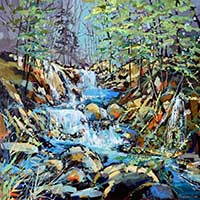In order to give you the best browsing experience our website uses cookies. By using our site, you are accepting our use of cookies. Please see our privacy policy.
Caring for Your Artwork
Work on canvas, especially oils, will last several lifetimes if cared for properly. Here is my handy guide on how to keep your painting looking as brilliant as the day you bought it for many years to come. The artworks shown in this chapter are available at Art2Arts online gallery.
Transporting your painting
Any painting you buy from Art2Arts is sent by dedicated courier so you don’t have to worry about transport when you order. However, if you later move house, there are a few need-to-knows to avoid your painting getting damaged.
The key is to pack and lift paintings separately. Don’t lift more than one in a stack as they might scratch one another or put a bend in the canvas. It is important to bubble wrap the canvas to protect it. When carrying the canvas, make sure you don’t take it by the top of the frame or the stretcher as this could distort it. Simply use two hands on each side of the frame to lift it. It is important to either wash your hands or to wear gloves. The dirt from your hands can interact with the oil and this can affect the canvas face.
Where to hang paintings
To make sure the paintings will last for many generations to come, it is important to hang the artwork in an area with moderate humidity, away from direct exposure to the sun and away from any heat sources.
If the area is too dry, the painting might dry out and crack; if it is too humid, this could cause mould growth. Avoid rapid changes in heat and humidity as these can cause the canvas or frame to distort. Heat sources such as radiators and fireplaces can soften the paint allowing dirt particles to get into the paint. As for the sunlight, it is best to avoid it as even the best pigments are likely to fade over time if exposed to direct and strong sunlight.
When hanging paintings it is also a good idea to think about ergonomics: avoid placing them where people are likely to bump into them or brush against them.
Cleaning and maintaining your painting
As it is best not to interfere with the painting as much as you can, in general, you won’t need to clean your painting. However, if the painting will start to look dusty, you can use a feather duster or a lint-free cloth for light dusting. This is important from time to time as oil paint tends to absorb dirt over the years. Avoid using sprays or chemical cleaners on the face of the painting. If necessary, you can use a damp cloth to remove splashes or dirt.
If the canvas begins to feel loose, just gently tap the wooden tension wedges, which are behind the canvas in each corner of the frame, with a hammer.












